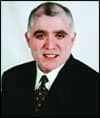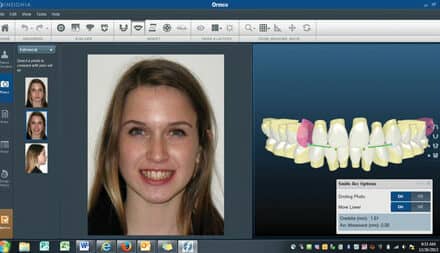
Nanda: My interest in biomechanics started when I joined the University of Connecticut’s orthodontic department as a young faculty member in 1972.
Unfortunately, in orthodontics we usually apply force at the level of the brackets, which, being substantially below the center of resistance of teeth, often moves the crowns and the roots in different directions, or maybe the crown in the right direction and the root in the wrong direction. In this situation, an orthodontist will correct root positions later, after placing crowns in a desirable position. The net result is that it takes longer to move teeth and one reaches treatment objectives in a roundabout way. If one was using a biomechanic strategy, force and a moment could be simultaneously applied to move both crown or roots together, or at least not allow the roots to move in the wrong direction.
When we say “biomechanic strategy,” we are being more specific about designing a force system often directed to a patient’s needs or treatment plan. This way, we are not using “canned” or “packaged” mechanics, but rather patient-specific mechanics, which would move teeth from position A to position B within the shortest possible time, with minimal force and the least amount of irreversible damage to the tooth and periodontium.
Let’s see how biomechanic strategies can differ from an orthodontic technique where only straight wires are being used throughout the treatment. A round straight wire (I am not talking here about Straight Wire Technique) placed in brackets only has the ability to expand, flare, or extrude teeth. With a rectangular wire, one can improve control of the roots. Using prescription brackets helps improve position of teeth in first, second, and third orders. This plan works very nicely in a large number of patients who need alignment of teeth and do not present significant malocclusion.
Now let us look at patients who have deep bites, anterior and/or posterior open bites, noncoincident anterior or posterior occlusal planes, dental or skeletal midline shifts, tipped anterior occlusal planes, and other modest to severe malocclusions. Placement of a straight wire in these situations will probably exacerbate the problem or give a very unsatisfactory result. So if your treatment plan is to intrude or extrude specific teeth, correct midlines in one arch by tipping or translating teeth, retracting teeth en masse in extraction patients without any loss of anchorage, and so on, you must have a problem-specific “mechanics plan” to achieve your treatment-plan goals.
OP: How do you deal with “smile line” and “canted occlusal plane”?
Nanda: “Smile line” relates to the relationship of upper lips to the upper occlusal plane. Just-completed research at our department has helped define different types of smile lines and how they differ in males and females. A significant paper is almost ready to be sent for publication on this subject that will further define smile dynamics and how we can incorporate them into our treatment. For example, we can improve smile line in deep-bite patients who show gingiva when their lips are relaxed or are smiling by intruding teeth with biomechanically designed, site-specific forces.
“Canted occlusal plane” refers to an anterior or posterior occlusal plane that is angulated and needs intrusion or extrusion at one end to level the plane. To achieve this movement, you must apply moments at the center of resistance or equal and opposite moments at strategic points at the occlusal plane.
OP: Do you use different strategies for adolescents and adults?
Nanda: Biomechanic strategies for adults and adolescents can be the same or different, based on the problem. For example, in adults the objective is to use noncompliant mechanics. With the application of differential moments in adults, there is no need to use elastics to retract teeth or to bolster anchorage.
I would like to emphasize in the end that biomechanics is not treatment-philosophy specific. Its basic principles are valid for each and every orthodontic technique. My often-repeated mantra is for our profession to move away from personality-driven orthodontics to appliance-driven orthodontics, and to demand evidence-based, rather than anecdotal, results.
Ravindra Nanda, BDS, MDentSc, PhD, is a professor and head of the Department of Orthodontics at the University of Connecticut. He is the author of numerous books, including Biomechanics and Esthetic Strategies in Clinical Orthodontics. He can be reached at [email protected].









